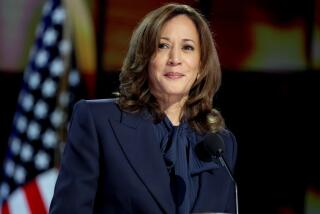‘92 DEMOCRATIC CONVENTION : Setting the Stage
- Share via
Space, or lack of it, will be an important part of the Democratic National Convention at Madison Square Garden. Fewer than a quarter of the delegates can fit on the convention floor, leaving the others in the Garden’s spectator seating, some of it high above the floor or in the “end zones.” But, although this seems like a handicap, it could help convention planners project an intimate setting that looks better on television. Here’s a look at the site and what will take place there:
Garden Flashback
In the 1976 Democratic National Convention at the Garden, there were usually between 5,000 and 7,000 people on the floor during sessions. Many of them walked under a sign, hung on a camera platform, saying that New York City codes called for a maximum capacity of 2,476.
No Public Seating
Because of security precautions and space limitations, the general public is not expected to be admitted.
The Video Wall
This year’s innovation is a 17-foot high wall of video monitors behind the speaker’s lectern. Dubbed the “video wall,” it will be used to introduce speakers and run taped segments.
Network Anchor Booths
The anchors for the major networks will not have their usual booths close to the floor. Instead they’ll be removed from the action, in sky boxes three levels above the VIP section.
Facts and Figures
Delegates: 4,288
Alternate delegates: 640
Delegate breakdown: 50% male, 50% female
Delegates needed to win the nomination: 2,145
Media representatives: 15,000
Foreign dignitaries: 500
Media trailers outside Garden: 60
Miles of cable laid beneath the Garden: 189
Number of police officers assigned to convention: 3,000
Estimated economic impact of the convention on the city: $473 million
Cost of convention security: $6.6 million
Amount spent by city on convention: $20.8 million.
Average humidity inside convention hall: 77%
Number of monitors in podium’s “video wall”: 57
A Primer on What Will Happen
Keynote Speeches
This will happen on Monday, when New Jersey Sen. Bill Bradley, Georgia Gov. Zell Miller and former Texas Rep. Barbara Jordan speak. The speeches are, in effect, the convention’s opening monologue, in which the speakers praise the party’s position while taking jabs at the opposition. Three keynoters are a new twist; ordinarily, there is only one.
The Platform
The platform--a blueprint of what the party stands for--will come up on Tuesday. The presumptive nominee, Bill Clinton, exerted a powerful influence over it, as is customary. The platform was hammered out by a committee well before the convention and completed last month. It will be presented to the convention by Colorado Gov. Roy Romer and Rep. Nancy Pelosi of San Francisco, co-chairmen of the platform committee.
Balloting
The states vote alphabetically in a roll call on Wednesday. Each state’s speaker calls out the state’s vote, which can be divided among the candidates.
Nomination
New York Gov. Mario M. Cuomo will nominate Clinton on Wednesday, and someone--as yet unknown--will second the nomination. Paul E. Tsongas, who came in third in the delegate tally, has decided not to be nominated. But Edmund G. (Jerry) Brown Jr., who came in second, will be.
Floor demonstrations
After a candidate is nominated, the convention floor explodes into demonstrations. The rowdy displays are intended to show how popular a candidate is. In earlier days, it was intended to impress other delegates. Today, it’s mostly for TV.
Choosing a Vice President
A formality. Candidates pick their running mates and delegates are expected to agree. Vice presidential nominees are usually chosen to balance a ticket. Then, on Thursday, the candidate’s choice is nominated and seconded, and the convention ratifies whoever it turns out to be. Ordinarily, the candidate does not announce his choice until after his own nomination, but Clinton jumped the gun last week, selecting Sen. Albert Gore Jr. of Tennessee.
Vice Presidential Speech
The vice presidential nominee Gore is expected to speak on Thursday, after the convention confirms him and before Clinton speaks.
Acceptance Speech
The winner, presumably Clinton, will take the podium in the convention’s waning moments Thursday and get a chance to introduce himself to the nation. The speech will be his kickoff for the general election campaign. Losing candidates are expected to smile as a huge demonstration for the nominee caps the convention.
Sources: Democratic National Committee; Times wire services; Times staff reports
More to Read
Get the L.A. Times Politics newsletter
Deeply reported insights into legislation, politics and policy from Sacramento, Washington and beyond. In your inbox twice per week.
You may occasionally receive promotional content from the Los Angeles Times.










